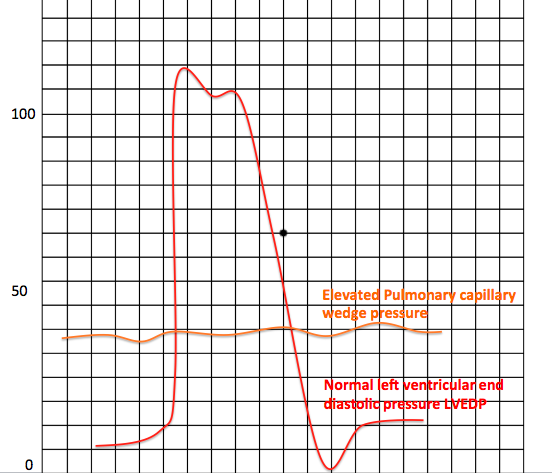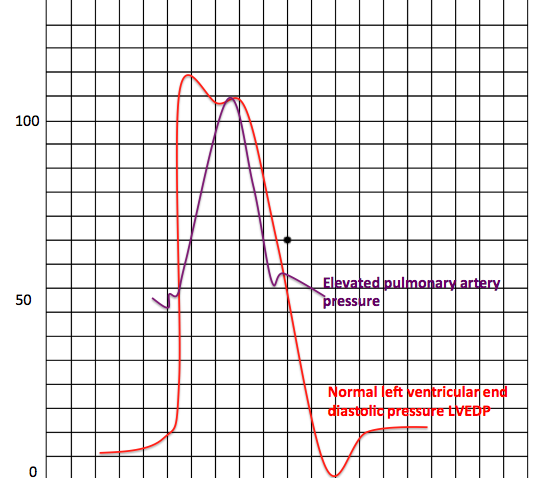Pulmonary hypertension other diagnostic studies
|
Pulmonary Hypertension Microchapters |
|
Diagnosis |
|---|
|
Treatment |
|
Case Studies |
|
Pulmonary hypertension other diagnostic studies On the Web |
|
American Roentgen Ray Society Images of Pulmonary hypertension other diagnostic studies |
|
Risk calculators and risk factors for Pulmonary hypertension other diagnostic studies |
Editor-In-Chief: C. Michael Gibson, M.S., M.D. [1]; Assistant Editor(s)-in-Chief: Ralph Matar; Rim Halaby
Overview
Pulmonary hypertension diagnosis is made using right heart cardiac catheterization. It is mandatory for diagnosing pulmonary arterial hypertension. It confirms the diagnosis and evaluates for some causes such as valvular heart diseases. Other studies may also be performed. These studies include pulmonary function tests, overnight oximetry, and ventilation-perfusion studies (which is crucial to rule out chronic pulmonary thromboembolism).
Key Findings in Right Heart Catheterization in Pulmonary Hypertension
- Right heart catheterization allows the determination of:[1][2][3][4][5][6]
- Presence or absence of pulmonary hypertension, the underlying etiology, and the prognosis.
- Prognostic markers such as right atrial pressure, cardiac output, and mean pulmonary artery pressure.
- Pulmonary venous pressures by measuring pulmonary capillary wedge pressure (PCWP).
- Fick’s method is reliable in patients with PAH for the measurement of cardiac output:
- Cardiac Output = oxygen consumption/arteriovenous oxygen difference x 100
- Since end-expiratory intrathoracic pressure most closely correlates with atmospheric pressure, it is important that all right ventricular, pulmonary artery, pulmonary wedge, and left ventricular pressures be measured at end-expiration.
- The causes of pulmonary hypertension can be classified into three categories which are each characterized by different ranges of values recorded by right heart catheterization.
- Pre-capillary pulmonary Hypertension (involving the pulmonary artery and arterioles)
- Capillary pulmonary hypertension
- Parenchymal lung diseases
- Post capillary pulmonary hypertension (passive congestion that leads to elevated capillary wedge pressure)
- Accordingly, the expected results by right heart catheterization are:
- Precapillary pulmonary hypertension
- Mean pulmonary artery pressure > 25 mm Hg. In primary pulmonary hypertension the pulmonary artery diastolic pressure is much higher than the pulmonary capillary wedge pressure.
- Capillary wedge pressure < 15 mm Hg (knowing that the normal PCWP or left ventricular end diastolic pressure (LVEDP) is less than 8 mmHg)
- Cardiac output: normal
- Postcapillary pulmonary hypertension
- Mean Pulmonary artery pressure > 25 mm Hg
- Capillary wedge pressure > 15 mm Hg. If the pulmonary hypertension is due to left-sided heart failure, and the pulmonary artery diastolic pressure in the pulmonary capillary wedge pressure will be both similarly elevated.
- Cardiac output: normal or low
- Precapillary pulmonary hypertension
Other Diagnostic Studies
- The other diagnostic studies are as follows:[7][8]
- Pulmonary function tests
- The aim of pulmonary function tests is to detect any obstructive or restrictive patten of an underlying lung disease that might be causing the pulmonary hypertension.
- Overnight oximetry
- Overnights oximetry might be used in some patients with pulmonary hypertension in order to assess the necessity of oxygen therapy during sleep time.
- Ventilation-perfusion studies
- Ventilation-perfusion studies are done to rule out any thromboembolic diseases in the lungs.[9]
- Pulmonary function tests
References
- ↑ Rosenkranz S, Preston IR (December 2015). "Right heart catheterisation: best practice and pitfalls in pulmonary hypertension". Eur Respir Rev. 24 (138): 642–52. doi:10.1183/16000617.0062-2015. PMID 26621978.
- ↑ Guo X, Liu M, Ma Z, Wang S, Yang Y, Zhai Z, Wang C, Zhai R (2014). "Flow characteristics of the proximal pulmonary arteries and vena cava in patients with chronic thromboembolic pulmonary hypertension: correlation between 3.0 T phase-contrast MRI and right heart catheterization". Diagn Interv Radiol. 20 (5): 414–20. doi:10.5152/dir.2014.13501. PMC 4463330. PMID 25163757.
- ↑ Greiner S, Jud A, Aurich M, Hess A, Hilbel T, Hardt S, Katus HA, Mereles D (August 2014). "Reliability of noninvasive assessment of systolic pulmonary artery pressure by Doppler echocardiography compared to right heart catheterization: analysis in a large patient population". J Am Heart Assoc. 3 (4). doi:10.1161/JAHA.114.001103. PMC 4310406. PMID 25146706.
- ↑ D'Alto M, Romeo E, Argiento P, D'Andrea A, Vanderpool R, Correra A, Bossone E, Sarubbi B, Calabrò R, Russo MG, Naeije R (October 2013). "Accuracy and precision of echocardiography versus right heart catheterization for the assessment of pulmonary hypertension". Int. J. Cardiol. 168 (4): 4058–62. doi:10.1016/j.ijcard.2013.07.005. PMID 23890907.
- ↑ Hoeper MM, Lee SH, Voswinckel R, Palazzini M, Jais X, Marinelli A, Barst RJ, Ghofrani HA, Jing ZC, Opitz C, Seyfarth HJ, Halank M, McLaughlin V, Oudiz RJ, Ewert R, Wilkens H, Kluge S, Bremer HC, Baroke E, Rubin LJ (December 2006). "Complications of right heart catheterization procedures in patients with pulmonary hypertension in experienced centers". J. Am. Coll. Cardiol. 48 (12): 2546–52. doi:10.1016/j.jacc.2006.07.061. PMID 17174196.
- ↑ Taylor B, Rumbak M, Taylor SP, Solomon D (January 2013). "Early versus delayed right heart catheterization in evaluation of pulmonary arterial hypertension". J. Heart Lung Transplant. 32 (1): 137–8. doi:10.1016/j.healun.2012.10.004. PMID 23260714.
- ↑ Presberg KW, Dincer HE (2003). "Pathophysiology of pulmonary hypertension due to lung disease". Curr Opin Pulm Med. 9 (2): 131–8. PMID 12574693.
- ↑ Minai OA, Pandya CM, Golish JA, Avecillas JF, McCarthy K, Marlow S; et al. (2007). "Predictors of nocturnal oxygen desaturation in pulmonary arterial hypertension". Chest. 131 (1): 109–17. doi:10.1378/chest.06-1378. PMID 17218563.
- ↑ Poch D, Mandel J (2021). "Pulmonary Hypertension". Ann Intern Med. 174 (4): ITC49–ITC64. doi:10.7326/AITC202104200. PMID 33844574 Check
|pmid=value (help).

